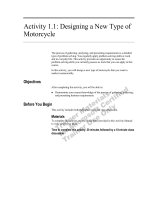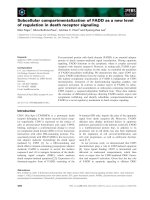Helminthosporium Vignicola - A new report of target leaf spot disease of cowpea Vigna Unguiculata (L.) Walp. from Odisha, India
Bạn đang xem bản rút gọn của tài liệu. Xem và tải ngay bản đầy đủ của tài liệu tại đây (418.34 KB, 5 trang )
Int.J.Curr.Microbiol.App.Sci (2019) 8(4): 809-813
International Journal of Current Microbiology and Applied Sciences
ISSN: 2319-7706 Volume 8 Number 04 (2019)
Journal homepage:
Original Research Article
/>
Helminthosporium vignicola- A New Report of Target Leaf Spot Disease of
Cowpea Vigna unguiculata (L.) Walp. from Odisha, India
S. Sahoo* and S.K. Beura
Department of plant pathology, CA, Odisha University of Agriculture and Technology,
Bhubaneswar-751003, Odisha, India
*Corresponding author
ABSTRACT
Keywords
Helminthosporium
vignicola, Target
leaf spot, Cowpea
Article Info
Accepted:
07 March 2019
Available Online:
10 April 2019
Helminthosporium vignicola, the incitant of target leaf spot of cowpea (Vigna unguiculata
(L.) Walp.) is a foliar fungal pathogen experienced for the first time during kharif- 2017
from AICRP on Vegetable crops, OUAT, Bhubaneswar and adjoining coastal tracts of
Odisha. The pathogen mainly infects the leaves, stems and fruits causing about 25-30%
loss in cowpea yield. The fungal pathogen was isolated, brought into pure culture and
identified as Helminthosporium vignicola. The morphological and etiological aspects of
fungus along with pathogenicity test have been carried out. Microscopic investigation
revealed, the conidia are fusiform, pale to mid dark brown, widened at the middle,
gradually tapering to round ends possessing 2-3 pseudosepta. The conidiophores are
solitary or in groups, emerging from dark brown to black stromata, straight or flexous,
sometimes geniculate, mid to dark brown and pale near apex and smooth. The dimension
of the conidia is in the range of 13.0-32 μm × 5.1-11 μm with an average range of 22.5 μm
× 8.05μm.
uplands during kharif season in inland
districts and under available soil moisture
during rabi season in coastal districts. Cowpea
is susceptible to fungal, bacterial and virus
diseases, which can result in substantial loss
in yield. Common diseases include blights,
root rot, wilt, powdery mildew, rust and leaf
spots. Among the leaf spot diseases,
Helminthosporium leaf spot disease is a new
emerging threat to all cowpea growers of
Odisha. Therefore, an attempt has been made
to identify the pathogen through normal
procedures and subsequent studies have been
undertaken on the pathogen.
Introduction
Cowpea (Vigna unguiculata) is an annual
herbaceous legume crop mostly used as
fodder, vegetable and a green manure crop.
This crop is suited to hot and humid climates
as well as to semi-arid areas. It is indigenous
to Africa from which it was introduced into
other tropical and subtropical countries
(Cobley and Steele, 1975). It is grown all over
India but in higher volumes in central and
peninsular regions. It is largely grown as
Kharif crop in some region of Maharashtra,
Andhra Pradesh, Karnataka and Tamil Nadu.
But in Odisha, cowpeas are mainly grown in
809
Int.J.Curr.Microbiol.App.Sci (2019) 8(4): 809-813
Materials and Methods
Single spore isolation
Collection of disease sample
A spore suspension was prepared in sterile
water and spore contents were ascertained by
examining a drop of suspension under the
microscope. Culture tubes containing 10ml of
sterile water agar were melted over water bath
and temperature was allowed to come down
to 400C. A loop full of spore suspension from
this tube was again transferred to second
culture tube containing melted agar. Likewise
a series of dilution of spores in the medium
were prepared which in turn poured in to the
sterilized petriplates one after another. All
petriplates were incubated in an incubator at
28±10C.
Disease samples were collected from AICRP
on Vegetable crops, OUAT, Bhubaneswar
and adjoining coastal tracts of Odisha (Jatni,
Balianta and Balipatna).
Isolation of plant pathogen
The leaves showing leaf spot symptoms were
collected infected leaves were cut into small
bits containing infected portions as well as
apparent healthy portions. These bits were
sterilized with 0.5% sodium hypochlorite for
2 minutes and then washed serially thrice to
remove excess chemical. Then the bits were
transferred to sterilized petriplates containing
potato dextrose agar. The petriplates were
kept in an incubator at room temperature of
26-280C and the observations were taken
periodically. After seven days of incubation,
fungal colonies completely covered the plates
and became black in colour indicating the
production of spores.
Purification
fungus
and
identification
of
After 24 hours of incubation, the petriplates
were examined in an inverted position and
germinating spores were located and marked
with the help of glass marking pencil. A small
amount of medium in the marked area
containing
germinating
spores
were
transferred by means of a sterile inoculating
needle to the middle of potato dextrose agar
medium slant under aseptic condition. The
slants with single germinating spore were
incubated in a BOD incubator at 28±10C.
After 2-3 days, the growth of the fungus was
observed in the slant. Thus a pure culture was
obtained.
the
Each isolate of fungus, maintained on PDA
slants, were transferred to agar plates. Hyphae
from the periphery of young colonies were
carefully examined and transferred to PDA
slants. This process was repeated for 2-3
times till the concerned fungus was found to
be free from other fungi and bacteria. Pure
culture of fungus was obtained through
‘single spore’ and ‘hyphal tip’ methods.
Hyphal tip isolation
The fungus was grown in a sterile petridish
containing potato dextrose agar medium. As
isolated, hyphal tip was located under the
microscope and marked with the help of sharp
glass marking pencil. The tip was carefully
lifted up and transferred by sterilized
inoculating needle to a potato dextrose agar
slant at room temperature. After 2-3 days, the
growth of fungus was noticed in the culture
tube and thus, a pure culture of the fungus
was obtained and it was maintained by
repeated sub- culturing.
The characteristics of the fungal colony on
PDA and the details of their morphology were
recorded for each isolate. Each isolate was
taxonomically identified with the help of
available cultures and literature.
810
Int.J.Curr.Microbiol.App.Sci (2019) 8(4): 809-813
suspension containing mycelia bits of the
fungus was prepared by using sterilized water.
Then, the suspension was sprayed on the pin
pricked leaves.
Maintenance of culture
The pure culture of the fungus was
maintained on Potato Dextrose Agar (PDA)
slants throughout the period of investigation.
The fungus was subcultured at an interval of
two months and stored at 25 1C.
The control plants were sprayed with only
sterilized distilled water. After spraying, all
the plants were covered with polythene bags
and kept inside a glass house at 250c and 95%
RH. Observations on occurance of disease
symptom were taken periodically.
Identification of the culture
The identification of fungal pathogen was
done based on the spore morphology and
colony characters (Barnett and Hunter, 1972)
and Demataceous hyphomycetes (Ellis,
1971).
To
identify
the
pathogen,
morphological and cultural characters of the
fungus isolated from cowpea were studied in
laboratory under the microscope and
compared with the original monogram
describing the morphological characterstics of
the fungus.
Some regions on the leaf lamina were selected
and the places were marked by marker. The
marked portions were smeared with mycelial
bits by using a cotton plug. The control plants
were smeared with sterilized distilled water.
The symptoms were appeared 4-5 days after
inoculation and reisolation was made from
such spots to prove pathogenecity according
to koch’s Postulate.
Proving pathogenicity
Results and Discussion
Pathogenicity was proved on cowpea variety
Utkal Manika. The healthy plants were raised
in polybags. Two methods were used to
undertake study.
Target leaf spot disease of cowpea was found
to be a major disease for all cowpea growers
of coastal part of Odisha. Occasionally, this
disease was also associated with the stem and
pods which reduced the market value (Fig. 1–
3).
The leaves of the plants were surface
sterilized and were pin pricked with the help
of sterilized needle. For inoculation, a
Fig.1 (A) Pure culture in slants (B) Pure culture at seven days after inoculation (C) Pure culture
at 15 days after inoculation (spore suspension)
811
Int.J.Curr.Microbiol.App.Sci (2019) 8(4): 809-813
Fig.2 Microphotograph showing conidia and conidiophores
Fig.3 Pathogenicity test
MYCELIAL BITS
THREE DAYS AFTER INOCULATION
Diseased plant
Healthy plant
812
Int.J.Curr.Microbiol.App.Sci (2019) 8(4): 809-813
The first symptom in the field was
characterized by presence of circular to
irregular light brown or ashy coloured spots
with dark brown margins. Later, the spots
coalesced with each other to form a large
patch in the leaves.
emerging from dark brown to black stromata,
straight or flexous, sometimes geniulate, light
to dark brown and pale near apex and smooth.
The dimension of the conidia is in the range
of 13.0-32.0 μm × 5.1-11.0 μm with an
average range of 22.5μm × 8.05μm.
On pathogenicity, the causal fungus could
induce the typical symptoms on the test plants
at 4-5 days after artificial inoculation.
However, the plants without inoculation did
not exhibit any such symptoms. Thus, it
proved Koch’s postulate.
References
Barnett HL and Hunter BB. 1972. Illustrated
Genera of Imperfect Fungi. 3rd Edition,
Burgess Publishing Co., Minneapolis,
241 p.
Cobley LS and Steele WM. 1975. An
Introduction to the Botany of Tropical
Crops (London: Longman), 371 pgs.
Ellis
MB.
1971.
Dematiaceous
Hyphomycetes. Kew, England: Comm.
Mycol. Inst. Kew, Surrey, UK, pp. 932934.
Morphological studies revealed that the
conidia are fusiform, pale to mid dark brown,
widened at the middle, gradually tapering to
round ends possessing 2-3 pseudosepta.
The conidiophores are solitary or in groups,
How to cite this article:
Sahoo, S. and Beura, S.K. 2019. Helminthosporium vignicola- A New Report of Target Leaf
Spot Disease of Cowpea Vigna unguiculata (L.) Walp. from Odisha, India.
Int.J.Curr.Microbiol.App.Sci. 8(04): 809-813. doi: />
813









